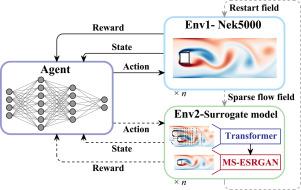Efficient active flow control strategy for confined square cylinder wake using deep learning-based surrogate model and reinforcement learning
IF 8
2区 计算机科学
Q1 AUTOMATION & CONTROL SYSTEMS
Engineering Applications of Artificial Intelligence
Pub Date : 2025-10-04
DOI:10.1016/j.engappai.2025.112468
引用次数: 0
Abstract
This study introduces a deep learning surrogate model-based reinforcement learning (DL–MBRL) for active control of two-dimensional (2D) wake flow past a square cylinder confined between parallel walls using antiphase jets. In the training of this framework, a proximal policy optimisation (PPO) reinforcement learning agent alternates its interaction between a deep learning-based surrogate model (DL–SM) and a computational fluid dynamics (CFD) simulation to suppress wake vortex shedding, thereby significantly reducing computational costs. The DL–SM, built with a Transformer for temporal dynamics and a multiscale enhanced super-resolution generative adversarial network (MS–ESRGAN) for spatial reconstruction, is trained on 2D direct numerical simulation wake flow data to effectively and accurately emulate complex nonlinear flow behaviours. Compared to standard model-free reinforcement learning, the DL–MBRL approach reduces training time by about 50% while maintaining or improving wake stabilisation. Specifically, it achieves approximately a 98% reduction in shedding energy and a 95% reduction in the standard deviation of the lift coefficient, demonstrating strong suppression of vortex shedding. By leveraging the inherent stochasticity of DL–SM, DL–MBRL also addresses the nonzero mean lift coefficient issue observed in model-free methods, promoting more robust exploration. These results highlight the potential of the framework for extension to practical and industrial flow control problems.

基于深度学习的代理模型和强化学习的方形圆柱尾流有效主动控制策略
本研究引入了一种基于深度学习代理模型的强化学习(DL-MBRL),用于使用反相射流主动控制二维(2D)尾流通过被限制在平行壁面之间的方形圆柱体。在该框架的训练中,近端策略优化(PPO)强化学习代理在基于深度学习的代理模型(DL-SM)和计算流体动力学(CFD)模拟之间交替交互,以抑制尾流脱落,从而显著降低计算成本。DL-SM采用了用于时间动力学的Transformer和用于空间重建的多尺度增强型超分辨率生成对抗网络(MS-ESRGAN),在二维直接数值模拟尾流数据上进行训练,以有效准确地模拟复杂的非线性流动行为。与标准的无模型强化学习相比,DL-MBRL方法在保持或改善尾流稳定性的同时减少了约50%的训练时间。具体来说,它可以减少约98%的脱落能量,并将升力系数的标准偏差降低95%,显示出对旋涡脱落的强大抑制。通过利用DL-SM固有的随机性,DL-MBRL还解决了在无模型方法中观察到的非零平均升力系数问题,促进了更稳健的探索。这些结果突出了该框架扩展到实际和工业流控制问题的潜力。
本文章由计算机程序翻译,如有差异,请以英文原文为准。
求助全文
约1分钟内获得全文
求助全文
来源期刊

Engineering Applications of Artificial Intelligence
工程技术-工程:电子与电气
CiteScore
9.60
自引率
10.00%
发文量
505
审稿时长
68 days
期刊介绍:
Artificial Intelligence (AI) is pivotal in driving the fourth industrial revolution, witnessing remarkable advancements across various machine learning methodologies. AI techniques have become indispensable tools for practicing engineers, enabling them to tackle previously insurmountable challenges. Engineering Applications of Artificial Intelligence serves as a global platform for the swift dissemination of research elucidating the practical application of AI methods across all engineering disciplines. Submitted papers are expected to present novel aspects of AI utilized in real-world engineering applications, validated using publicly available datasets to ensure the replicability of research outcomes. Join us in exploring the transformative potential of AI in engineering.
 求助内容:
求助内容: 应助结果提醒方式:
应助结果提醒方式:


